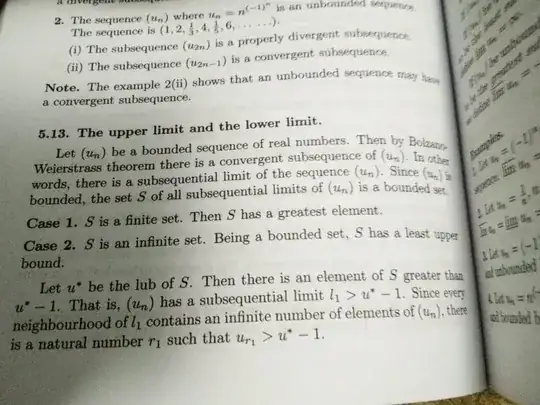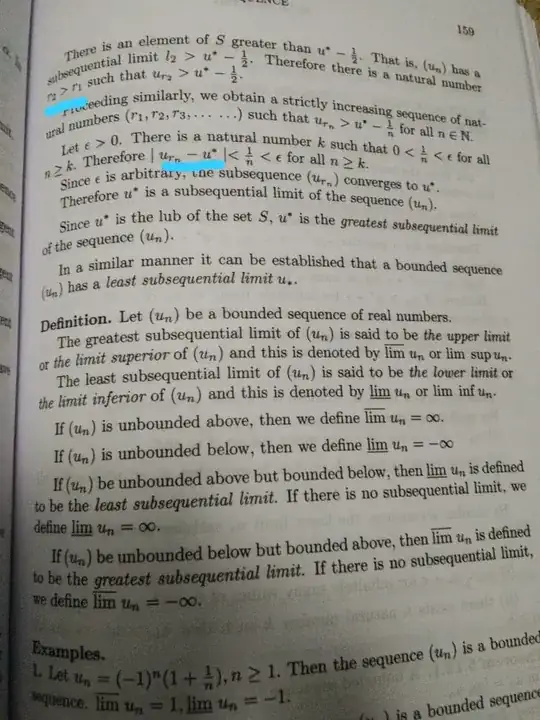I just realized I ended up answering the question in the comments, so here's maybe a more fleshed out version of what I wrote in the comments.
Let's suppose $u^*$ is the least upper bound. If we subtract $1$ from it, then it is no longer an upper bound, meaning there is subsequential limit $\ell_1$ (meaning there is a subsequence which converges to $\ell_1$) with the property that $\ell_1 > u^* - 1$. Since this is a subsequential limit, we can use the definition to figure out there has to be infinitely many $u_n$ which satisfy the condition that $u_n > u^* - 1$. Let's choose $r_1$ to be one of these.
Now let's try subtracting $1/2$, so we look at $u^* - 1/2$. Again, we know that there is a subsequential limit $\ell_2$ so that $\ell_2 > u^* - 1/2$, so there are infinitely many $n$ which satisfy the condition that $u_n > u^* - 1/2$. Now let's suppose they are all less than or equal to $r_1$. Well that means that we have infinitely many $n$ between $1$ and $r_1$, but this is silly because we know there are only finitely many. So there must actually be infinitely many $n$ which satisfy the condition that $n > r_1$ and $u_n > u^* - 1/2$. Choose one of these and set $r_2$ to be this.
Notice there's nothing special about these two cases. I could repeat this same kind of argument for $u^* - 1/3$ and find an $r_3 > r_2$ so that $u_{r_3} > u^* - 1/3$, and then do it for $1/4$, $1/5$, so on and so forth. So we have an increasing sequence $r_1 < r_2 < \cdots < r_n < \cdots $ which satisfies the condition that $u_{r_n} > u^* - 1/n$.
EDIT: I was not fully paying attention when I wrote the answer. It is a good question to ask why $u_{r_n} < u^* + 1/n$. I will edit this with an answer later.
EDIT 2: Here's an updated answer.
Consider
$$ S = \{\ell \in \mathbb{R} : \exists \{n_j\}_{j=1}^\infty \text{ such that } u_{n_j} \rightarrow \ell\}.$$
We take the least upper bound of this set, so $u^*$ is the least upper bound of $S$. Let's go back to our choices of $\{r_n\}_{n=1}^\infty$ and let's be more careful about them. Notice that we have
$$u^* - 1 < \ell_1 \leq u^* < u^* + 1.$$
By definition of convergence, there are infinitely many $u_n$ which satisfy
$$ u^* - 1 < u_n < u^* + 1.$$
Choose $r_1$ to be an $n$ which satisfies this. Now if we subtract $1/2$, there is an $\ell_2$ so that
$$ u^* - 1/2 < \ell_2 \leq u^* < u^* + 1/2.$$
Again, there are infinitely many $u_n$ which lie between these bounds by the definition of convergence. Choose $r_2 > r_1$ so that this holds. Now repeat the process to create an increasing sequence $\{r_n\}_{n=1}^\infty$ so that
$$ |u_{r_n} - u^*| < 1/n.$$
Use the Archemedean principle to get convergence.

